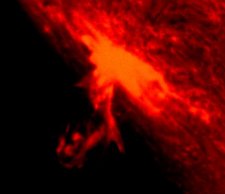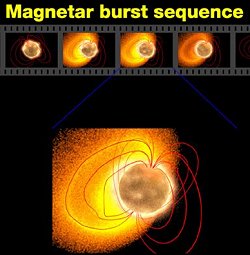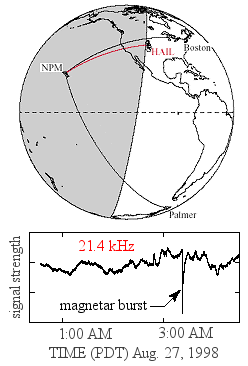|
Solar flares that scorch Earth's atmosphere
are commonplace. But scientists have discovered a few each year
that are not like the others: they come from stars thousands of
light years away.
by Dr Tony Phillips

A solar flare
blasts hot gas away from the limb of the Sun.
|
On August 24th, 1998, there was an explosion on the sun as
powerful as a hundred million hydrogen bombs. Earth-orbiting satellites
registered a surge of x-rays. Minutes later they were pelted by
fast-moving solar protons. Our planet's magnetic field recoiled
from the onslaught, and ham radio operators experienced a strong
shortwave blackout.
None of these things
made headlines. The explosion was an "X-class" solar
flare, and during years around solar maximum, such as 1998, such
flares are commonplace. They happen every few days or weeks. The
August 24th event was powerful, yet typical.
A few days later -
no surprise - another blast wave swept past Earth. Satellites
registered a surge of x-rays and gamma-rays. Hams experienced
another blackout. It seemed like another X-class solar flare.
Except for one thing: this flare didn't come from the sun.
It came from outer space.
"The source of the
blast was SGR 1900+14 - a neutron star about 45,000 light years
away," says NASA astronomer Pete Woods. "It
was the strongest burst of cosmic x-rays and gamma rays we've ever
recorded."
SGR 1900+14 is a special kind of neutron
star called a magnetar. "Magnetars
have the strongest magnetic fields in the universe: a million billion
(1015) gauss," he says. For comparison, the magnetic
field of the sun is less than 10 gauss in most places, and about
1000 gauss near sunspots.

An artist's concept
of a magnetar outburst. The red loops trace the star's
intense magnetic field.
|
Magnetism and
solar flares go together. On the sun, flares happen when magnetic
fields above sunspots become twisted and stretched. They're like
rubber bands pulled too tightly. Snap! They recoil with explosive
results. Physicists call this "magnetic reconnection."
Physicist Maxim Lyutikov
of McGill University thinks the same thing happens on magnetars. "I
imagine that the atmosphere of a magnetar is similar to the solar
corona - filled with plasma and complicated magnetic fields," he
says. "Reconnection on the sun
is often caused by a plasma instability called the 'tearing mode.'
Detailed calculations show that a similar instability may develop
in the strongly magnetized plasma of a magnetar."
Reconnection events on the sun emit as much as 1032 ergs
of energy. Flares from magnetars are about a million million times
stronger, ~1044 ergs, befitting their more intense magnetic
fields.
"They're solar flares on steroids," quips
Woods.
When the blast wave
from SGR 1900+14 arrived on August 27th, 1998, it hit the night
side of our planet - something flares from the sun never do - and
scorched Earth's upper atmosphere. The radiation broke apart
atoms and molecules into charged ions. Ions interact with radio
signals, either absorbing or reflecting them, so radio listeners
knew something had happened.
For instance, a registered
nurse in Seattle was driving home from work at 2:00 a.m. listening
to a local program on her car radio. The station faded - a blackout
- and was moments later replaced by country music from Omaha,
Nebraska. On the US east coast, where dawn was breaking at the
time, hams chatting locally suddenly picked up voice transmissions
from distant parts of Canada. Strange.

more
Stanford University's network
of VLF receivers registered a fadeout of 21.4 kHz signals on August
27, 1998, when the magnetar burst reached Earth. The shaded area
denotes the part of our planet illuminated by the burst.
|
These propagation
effects, so much like those experienced during ordinary solar
flares, quickly subsided. No harm was done. Nevertheless, the
event made a deep impression on astronomers. From halfway across
the galaxy, SGR 1900+14 had "touched" our planet.
It happens more often than most people
know. Since 1998, Earth has experienced "about 10 similar ionization events," says Umran
Inan of Stanford University. "Five of them were caused by SGR 1900+14,
and the rest from unknown sources."
Inan leads the Very Low Frequency
(VLF) Research Group at Stanford University. He and his colleagues
operate a network of low-frequency radio stations in North America
and Antarctica. When Earth gets hit by ionizing radiation, the
network records telltale changes in radio propagation. "We saw the blast from SGR 1900+14 in 1998 - it
was very clear," he says.
"Many things can change the ionization of Earth's atmosphere," adds
Inan. "Lightning can do it. So can sudden bursts of auroras at
high latitudes." But these things cause local ionization.
Solar flares, on the other hand, have global effects, ionizing
the top of Earth's entire dayside atmosphere. Flares from magnetars
can ionize the nightside, too. These signatures - nightside vs.
dayside, global vs. local - help Inan identify the source of the
ionization.
His "unknown sources" are probably
magnetars not yet discovered by astronomers.
"The best way to pinpoint a magnetar," says Woods, "is to catch
it when it's bursting - but that's not easy because the bursts are
unpredictable and brief. Oftentimes they come and go in less than
one-tenth of a second." To date only ten of these stars are known.
Many more await discovery, he believes.

Image credit: Rob Duncan
The distribution of magnetar
candidates along the Milky Way. The red dot below the plane of the
galaxy is located in the Large Magellanic cloud.
|
Finding them is the job of the Interplanetary Network (IPN) - a
flotilla of spacecraft scattered around the solar system. Members
include Ulysses, 2001 Mars Odyssey, RHESSI and others. None of
these missions are dedicated to magnetar research, but each one
carries a gamma-ray or x-ray detector - usually for some unrelated
purpose. The detector on 2001 Mars Odyssey, for instance, is used
to hunt for subsurface ice on Mars. Catching magnetars is a bonus.
Here's how it works: When a wave of
radiation sweeps through the solar system, it hits the different
spacecraft at slightly different times. Astronomers can figure
out where the burst came from by comparing the arrival times. "It's simple triangulation," says
Kevin Hurley of UC Berkeley who leads the effort. "The Ulysses
spacecraft is particularly important because of its long looping
orbit around the Sun. Ulysses' great distance from the other spacecraft
makes the triangulation precise."
"Each year we pinpoint dozens of magnetar outbursts this way," he
says. Most are from already-known objects like SGR 1900+14, but
sometimes a new magnetar reveals itself. (Note: the majority of
the bursts detected by the IPN are faint; only the strongest few
ionize Earth's atmosphere.)
As soon as the Interplanetary Network locates a burster, the coordinates
are emailed to astronomers around the world so they can observe
the magnetar using their own telescopes on the ground. NASA missions
such as the Chandra X-ray observatory and the Rossi X-ray Timing
Explorer sometimes join the effort, too. Magnetar candidates attract
the attention of dozens of observatories.
That's understandable. "From a physics point of view," notes Woods, "the
energy reservoir in the magnetosphere and crusts of magnetars is
10 to 100 times bigger than the energy released during the August
27, 1998, outburst. So there is the potential for much higher-energy
events. It's a good idea to keep an eye on these things."
And an ear. The next time you're driving home in the middle of
the night and, unexpectedly, a country tune blares out of your
radio, you might wonder ... did a magnetar do that? The cosmos
is full of the strangest surprises.
|
